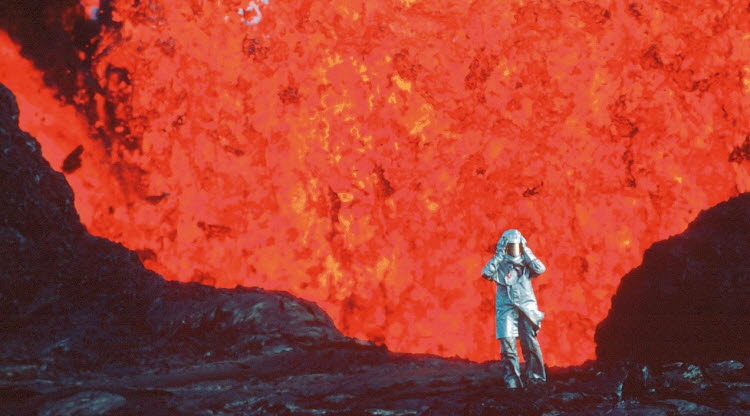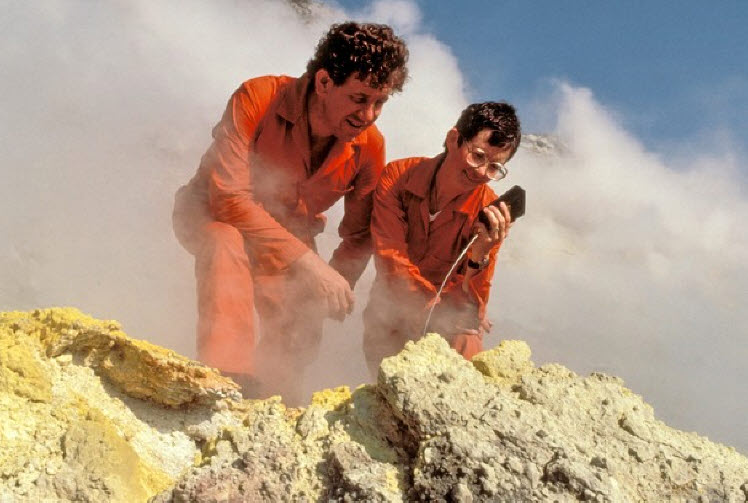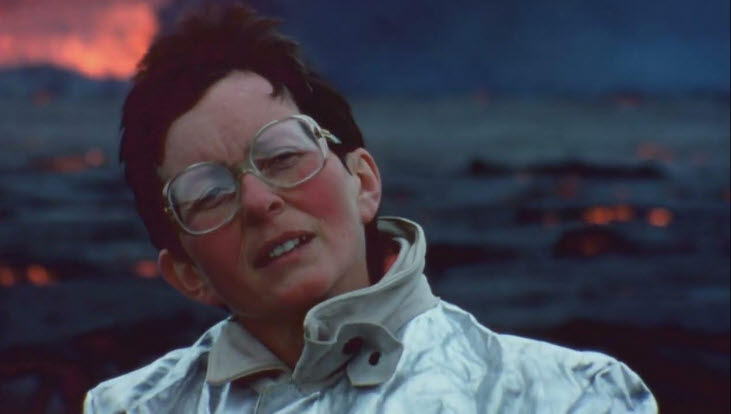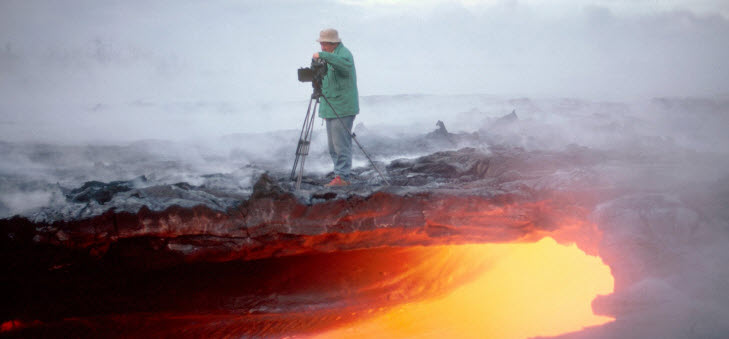Werner Herzog’s documentary film “The Fire Within: A Requiem for Katia and Maurice Krafft” is another prime example showing how Herzog has always been fascinated with a certain type of human figures. Many of his movies and documentaries are about fascinating people who are willing to go to the extreme for whatever they cannot help but pursue with all their heart, and Katia and Maurice Kraffts are no exception at all.
As many of you know, their life and career were already presented well in Sara Dosa’s recent Oscar-nominated documentary film “Fire of Love” (2022), which is currently available on Disney+. Considering that both of them mainly consist of numerous archival footage clips from the Kraffts, “Fire of Love” and Herzog’s documentary naturally overlap a lot with each other, but the latter is equally engaging for also having a fair share of awe-inspiring images to watch just like the former, and Herzog’s narration surely brings some touch of class as it did before in many of his acclaimed documentaries including “Grizzly Man” (2005).
While “Fire of Love” is a bit more drawn to the human personality of the Kraffts, Herzog’s documentary is a little more drawn to their professional dedication. Since they met and then married in 1970, Maurice and Katia Krafft, who happened to be born in the same rural region of France, frequently went here and there for observing many different volcanic eruptions around the world, and Herzog cannot help but show some admiration on how this couple advanced more and more as filmmakers during next several years. At first, Katia and Maurice simply recorded their scientific research works with their movie cameras, and their initial outputs look rather amateurish, but then they gradually showed more visual finesse as focusing more and more on closely capturing that terrifying wonder of volcanic eruptions on their cameras.
Starting with a huge volcanic eruption in Japan which tragically led to Maurice and Katia’s demise in 1991, Herzog looks around some of their archival footage clips one by one, and each of them is quite compelling and stunning to say the least. In case of the volcanic eruption which occurred on one small island of Indonesia in the early 1980s, Katia and Maurice quickly went to that island shortly after the first eruption, and then they vividly recorded its devastating aftermath before they hurriedly left because another big eruption was about to happen within a few minutes.
While initially throwing a dryly humorous or reflective comment here and there as expected, Herzog wisely steps aside more, mainly because those epic images boldly captured by the Kraffts speak enough for themselves on the screen. As a number of various classic pieces are played on the soundtrack, the documentary simply throws one archival footage of volcanic eruption after another, but you will find yourself often overwhelmed a lot by the immense visual beauty of these amazing moments, which will remind you more of how we all look inconsequential compared to many grand wonders of our big planet.
However, our big planet can also be quite harsh and ruthless to its living inhabitants, and the Kraffts came to focus more on the devastating catastrophes from volcanic eruptions especially after they directly witnessed the Armero tragedy in Colombia, 1985. Although the eruption of the Nevado del Ruiz stratovolcano was not that big compared to many other notable volcanic eruptions in the 1980s such as the eruption of Mount St. Helens of US in 1980, it was more than enough to melt a huge amount of glaciers on the top of the volcano, and this resulted in several enormous mudslides which quickly wiped out the surrounding area in addition to killing thousands of people living a small town named Armero. What the Kraffts closely recorded on their camera during that time was simply beyond words to say the least, and they naturally came to care more about how such catastrophes like that can be prevented.
Nevertheless, volcanic eruption is still an elusive and unpredictable subject even at this point, and that was one of the main reasons for the Kraffts’ endless fascination with volcanoes. When they went to that Japanese volcano in 1991, they were surely well aware of the possible risk and danger just like several others around them, but they still could not resist another good chance of capturing a volcano eruption on their camera.
As the documentary eventually focuses on several archival footage clips from the last several days of the Kraffts, Herzog sticks to his phlegmatic attitude as before while showing more respect and admiration toward their professional dedication. Yes, they could have avoided their death if they had been a bit more cautious, but they died while doing what they had been so passionate about for many years, and they also gave us something we can always behold with awe and wonder. Herzog has often said that our civilization has starved for new images, and we all can agree that the Kraffts thankfully nourish us with heaps of awesome visual stuffs we never saw before.
In conclusion, “The Fire Within: A Requiem for Katia and Maurice Krafft” is another terrific work from Herzog in addition to functioning as a sort of sibling piece to “Fire of Love”, which will certainly satisfy you if you want to know more about the Kraffts as human beings. I cannot decide now on which one is a better documentary, but I can tell you that both of them are very mesmerizing for their shared reasons, and I assure you that you will not waste your time at all if you decide to watch both of them.










